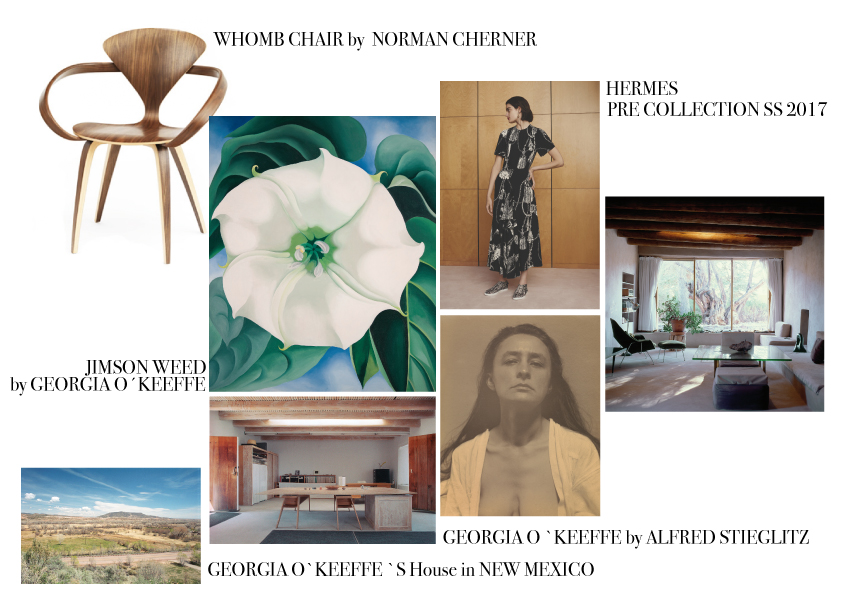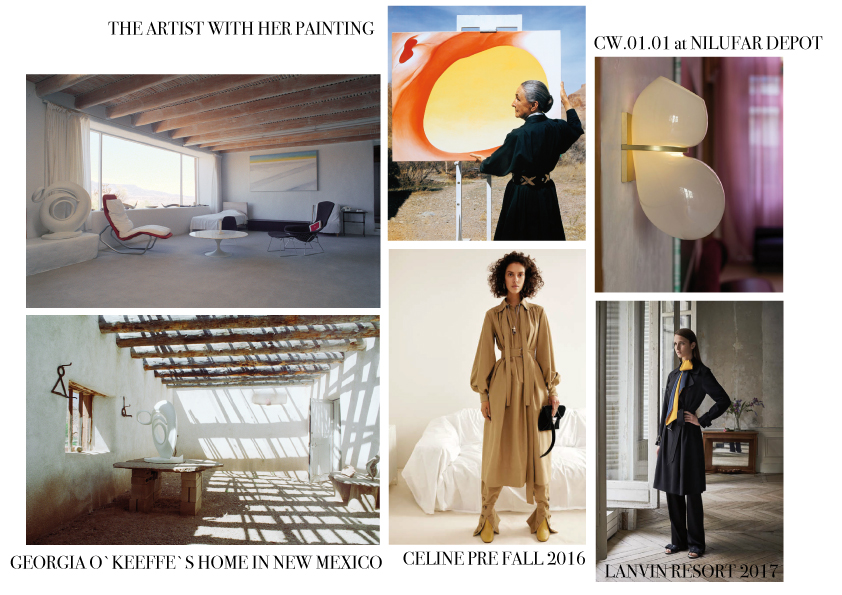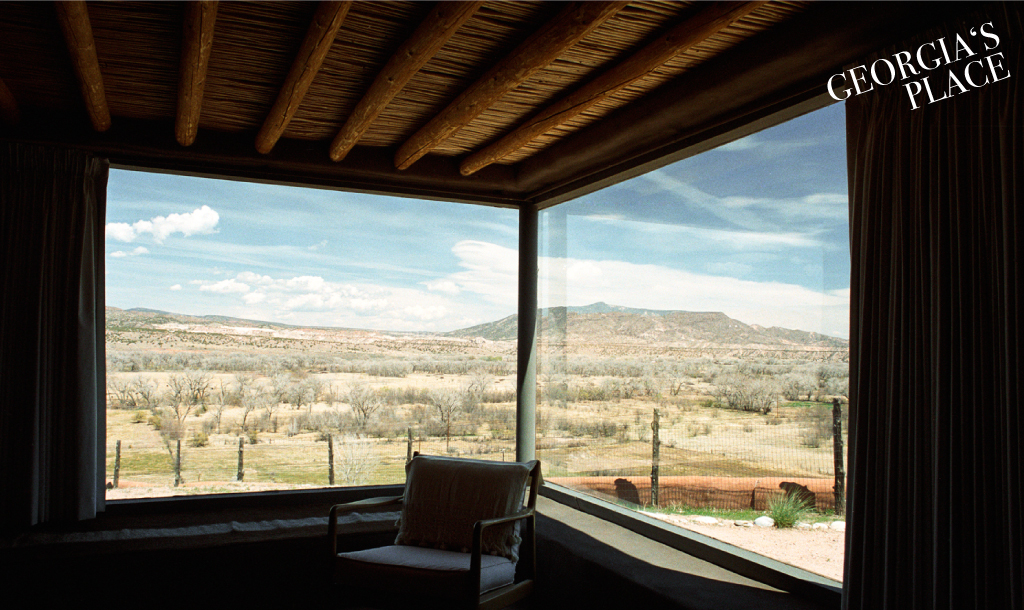
Georgia O’Keeffe is best known for her magnificent flower paintings but she was also the pioneer of a new modernism in America! She became an art icon and the first female artist who had a painting – Bear Lake, New Mexico (1930) – at the walls of the White House in Washington. One of her works, her picture Jimson Week/White Flower No. 1, which she painted in 1932, sold at Sotheby’s in New York in November 2014 for 44.4 million dollars. That makes Georgia O’Keeffe the most expensive female artist in the world and when she died in 1986 at the age of 99, she could look back on an exceptional and – for a woman of that time – and unusual life.
Reason enough to look at her paintings at the Tate Modern (until October 30, 2016) and a scrapbook of her work and style.
Where did it all start? Georgia was born as the second of seven children to a farmer couple on November 15, 1887, in Sun Prairie, Wisconsin. When she was six years old, her family moved to the beautiful town of Williamsburg in Virginia. It is said that Georgia was a loner and preferred nature to the company of man. Beside nature, she was very much drawn to art. In 1905 she started to study at the Art Institute of Chicago and later at the influential Art Students League in New York, where people such as Louise Bourgeois, Barnett Newman, Jackson Pollock, Donald Judd, Roy Lichtenstein and many more also studied.
Here, in the ‘Big Apple’, Georgia was a regular visitor of the then famous Gallery 291. The gallery was hub of avant-garde activities in New York and its program focused very much on European art. The gallery owner Alfred Stieglitz, who was foremost a well-known photographer, presented works by Rodin, Cézanne, Picasso, Matisse and others. At that time, little did Georgia know about her future with Stieglitz. But it was to take seven years till they ways crossed again.
In the meantime, between 1908 and 1915, Georgia worked first as a graphic artist and then as an art teacher in South Carolina. In her spare time she produced a large number of exceptional paintings and drawings. She sent some of the charcoal drawings to her New York friend Anita Pollitzer, who presented the drawings to Stieglitz. Stieglitz was stunned and fascinated. He immediately offered a show which took place in 1916. When Stieglitz met Georgia, he was not only interested in her work…. He asked her to model for him and he produced nearly 500 photographs of her. Some of them were extremely charged with eroticism, causing a sensation when they were published. It was partly due to these photographs that the people of New York flocked to her first exhibition which made her one of the most celebrated female artist in America.
Stieglitz asked Georgia to move to New York for good what she did. That was the beginning of a passionate love affair. A scandal was inevitable since Stieglitz was a married man. In 1918, after 24 years of marriage, he divorced his wife and married Georgia six years later. At the same time, she produced works for which she is best known: her flower paintings. They are inspired by the wonderful resort at Lake George where Stieglitz’s family had a summer house and where the couple vacationed every year to escape the heat in New York. Georgia rendered the flowers she found in the countryside or in the garden in a most unique way. Inspired by photography, she virtually zoomed in on the image so that some of her paintings seem abstract at first sight. They have often been described as symbolic of female sexuality. However, in 1943 she replied to an art historian: “I made you take time to look at what I saw and when you took time to really notice my flowers you hung all your own associations with flowers on my flower and you write about my flower as if I think and see what you think and see of the flower — and I don’t.”

top centre: Georgia O’Keeffe with “Pelvis Series, Red with Yellow”, 1960 Tony Vaccaro, Color photograph 14 3⁄4 x 17 in., frame: 20 1⁄4 x 24 1⁄4 in., Georgia O’Keeffe Museum, © Tony Vaccaro 2007.03.001; top right: CW.01.01 lamp in brushed brass with white glass, at Nilufar Depot, www.lindseyadelman.com/cw0101
After a few years, Georgia withdrew more and more. In spring 1929 she followed an invitation to Taos in New Mexico, where she found a landscape she marveled at: a spectacular combination of mountains, dry valleys and rough volcanoes. New Mexico left an immense impression on her. In the following years she spent half the year in New Mexico. She rented a house in the desert, collected stones and skulls to make them the motifs of her new paintings. In them, she circles around the theme of birth and death, life and decay – nature gives and nature takes. The isolated way of life gave her back an inner stability. Stieglitz openly struggled with her decision to move so far away; but she did not give in.
Stieglitz died in 1946. Three years later, Georgia moved to New Mexico for good. During the winter she lived at Ranchos de los Burros and spent the summer at the Ghost Ranch, an Adobe-style house which she first discovered in 1937. She loved Ghost Ranch so much that she started to move the household in the spring time when the snow had just begun to melt. Her very small team was not very amused because there was no central heating or electricity. There, she immersed herself in the countryside. Her paintings breath in the landscape: It is the red of the earth, the blue of the sky and the lakes, the black of the rocks and the white of the snow covered mountains that animate her canvases.
Everything was inspired by nature. Even her interior design was guided by the natural principles. She used merely natural materials in the colours of the desert. Her windows looked out into the Rio Chama Valley or framed the old trees in the garden. Her pictures convey this sense of simplicity, authenticity and solitude which were guiding values in her life.
Although, Georgia was known for protecting her privacy, she received guests at here houses, among them e.g. Charles and Anne Lindbergh or the writer Allen Ginsberg. About twice a year, she left her retreat and made visits to New York. She also kept reading art magazines and knew what was happening in the world. When she was in her 80s, she made a world trip. She took the plane and discovered a stunningly beautiful motif: the gaze out of the window when you are above the clouds. There, freedom is unlimited. So, she introduced that image into her paintings. Later in her life, Georgia started to lose her eye sight. Her trusted friend, colleague and assistant Juan Hamilton became her “second hand”. He guided her brush so that she could execute her paintings and potteries.
Georgia O’Keeffe died on March 6, 1986 at the age of 98 in Santa Fe. Today she is remembered as one of the most free-thinking artists that helped to bring American art out of its cultural backwater and into the Modernist mainstream. Above all, her name is a synonym for freedom, self-determination and self-fulfillment.

